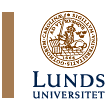

|
Panel No. 25Panel Title: South Asian Diaspora StudiesConvenor: Frank J. Korom, Departments of Religion and Anthropology, Boston University, USA Friday 9 July, 13–18 Panel Abstract: South Asian diaspora studies have grown remarkably as a sub-field within Indology over the past twenty years. This panel proposes to step back, take a look, and see where we have gone and where we still need to go to expand and refine this sub-field. For example, what geographical, linguistic, or ethnic regions/groups deserve more attention or have been missed altogether? Which groups have received the most attention and why? Moreover, how might we further refine our theoretical toolbox for analyzing South Asian communities living outside of South Asia. These are some of the questions that this panel proposes to answer by exploring historical and contemporary examples of South Asians in a world of diaspora and transnational movement.
Papers accepted for presentation in the panel:Paper Giver 1: Mohammad Mohiyuddin Mohammadd Sulaiman, Dept. for Strategic and Security Studies, National University Malaysia Paper 1 Title: Forced Repatriation of Indians by the Burmese Revolutionary Council in the 1960s Paper Abstract: It was the colonial British
who brought Indian indentured laborers to work in the Irrawady Delta.
Along with Indian laborers, the Chettayer caste, who lent money
on interest, exploited the agricultural situation by confiscating
Burmese land from those who could not return loans. In 1938, almost
80 percent of Burmese rice farms were in the hands of Chettayars,
which prompted a Burmese revolt against Indians led by Saya San
in 1938. Indian-Burmese riots, which were unfortunately transformed
into Muslims- Buddhist riots had caused enormous dissatisfaction
among the natives. The Burmese assumed the reason they remained
poor was due to Indians being rich. It was the general perception
of the Burmese that they were not successful in business because
Indians monopolized it. What is more, the British favors rendered
upon Indians had sowed further hatred towards Indians. Paper Giver 2: Deborah Sutton, Department of History, Lancaster University, UK Paper 2 Title: “All Races Must Work for the African:” Race, Identity and Citizenship between South Asia and East Africa, 1948 – 1963 Paper Abstract: This paper addresses identities
on the periphery of late colonial rule and post-colonial nationalism,
specifically, the population of South Asian origin in East Africa
whose identities were caught between an emergent nationalism in
East Africa and newly realized nationhood in India during the 1950s.
The 1948 British Nationality Act and the actual and imminent independence
of former British colonies in South Asia and East Africa created
four potential citizenship units for the population of South Asian
origin in East Africa: British, Indian, Pakistani or Kenyan. Ironically,
the legislative enactment of inclusion came to be punctuated and,
eventually characterized, by the trope of exclusion of the East
African Asians by African nationalists, the British immigration
authorities and the Indian state. By the early 1960s, political
and civic representation of the Indians of East Africa had become
a defensive identity politics wholly reactive to variously defined
transgressions of either Indian or African post-colonial nationalisms.
Existing accounts have relied on specificity and contingency to
explain the vilification of South Asians in East Africa. I'd like
to suggest that there are far more significant and resonant ways
to think about the discourses of nation, citizenship and race in
the 1950s that accumulated around the ‘Asian problem’
in East Africa by broaching conceptual issues of liberal rhetoric
and authoritarian practices of post-colonial citizenship. Paper Giver 3: Igor Kotin, Department of Oriental Studies, St.Petersburg State University, Russian Federation Paper 3 Title: South Asians in Russia: A New Element in the Multicultural Mosaic Paper Abstract: The South Asian diaspora and
particularly the Indian one became popular subject of research due
to its economic importance, growing numbers of South Asians overseas,
thanks to their visibility in such countries as Great Britain, Canada,
USA, not to speak of Fiji, Trinidad and Tobago, and Guyana. Many
other countries like Australia and New Zealand are becoming aware
of the growth of their populations of Indian, Pakistani and Bangladeshi
origin. Yet countries like Russia, Ukraine, and Belarus remain terra
incognita for scholars of the South Asian diaspora. While the numbers
for Belarus are negligent, this is not the case of Russia, where
estimates of Indians only vary from 40,000 to 50,000 while the number
of Pakistanis and Bangladeshis are smaller but still significant.
Full paper to be downloaded (as a pdf-file) Paper Giver 4: Girija Kaimal, Department of Education, Harvard University, USA Paper 4 Title: In the Land of Milk and Honey: The Indo-American Diaspora and Media Paper Abstract: Immigrants of Indian origin have had a unique place in American immigrant history. Beginning with the farm workers in California in the early twentieth century to the recent spate of high-tech skilled workers, Indian immigrants constitute over 2 million in number and span the spectrum from being one of the wealthiest ethnicities to having a sizably poor sub-group. In this paper I present an analysis of the dreams that lead Indians to the U.S. and how these aspirations, are depicted in the media (television and cinema). For the current generation that is born and raised in the U.S., these media depictions send implicit and sometimes damaging messages about the individual and his identity in society. I will use both depictions in the media as well as the choices made by diasporic Indians to understand how they negotiate the challenges of immigration and cultural distance. Full paper to be downloaded (as a pdf-file) Paper Giver 5: Lindsey Harlan, Department of Religion, Connecticut College, USA Paper 5 Title: Reversing the Gaze in America: Parody in Divali Performance at Connecticut College Paper Abstract: Examining the celebration of the Hindu holiday Divali at Connecticut College, this essay argues that various songs, dances, and skits demonstrate “self-conscious self-translation” of students from diverse cultures and regions of South Asia. In performance students reverse the gaze of U.S. citizens and set the terms for multicultural edification while gently critiquing various South Asian and American cultural codes. Among the performances examined are a Bharat Natyam dance to the theme song from the film “Austin Powers” and a Bollywood spoof in which a demure Indian wife follows her husband to New York City and becomes a Hollywood star after being discovered by Steven Spielberg. Paper Giver 6: Kirin Narayan, Department of Anthropology, University of Wisconsin— Madison, USA Paper 6 Title: Moving Stories: Family Folklore in the South Asian Diaspora Paper Abstract: As Stuart Hall has observed, "identities are the names we give to the different ways we are positioned by, and position ourselves within, the narratives of the past" (1994:394). Based on interviews with second-generation South Asian Americans, this paper argues that family stories--assorted narrative genres told about the family and within the family--are key sites for the transmission of a personal connection to the homeland and thus, the framing and reframing of a diasporic identity.
SASNET - Swedish South Asian Studies Network/Lund
University
|

